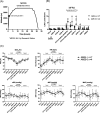Association between high cardiac output at altitude and acute mountain sickness: preliminary study on Mt. Fuji
- PMID: 37055843
- PMCID: PMC10099929
- DOI: 10.1186/s40101-023-00322-7
Association between high cardiac output at altitude and acute mountain sickness: preliminary study on Mt. Fuji
Erratum in
-
Correction: Association between high cardiac output at altitude and acute mountain sickness: preliminary study on Mt. Fuji.J Physiol Anthropol. 2023 May 19;42(1):7. doi: 10.1186/s40101-023-00324-5. J Physiol Anthropol. 2023. PMID: 37208712 Free PMC article. No abstract available.
Abstract
Background: Acute mountain sickness (AMS) affects around 30% of people climbing Mt. Fuji, but its pathogenesis is incompletely understood. The influence of a rapid ascent to high altitude by climbing and summiting Mt. Fuji on cardiac function in the general population is unknown, and its association with altitude sickness has not been clarified.
Methods: Subjects climbing Mt. Fuji were included. Heart rate, oxygen saturation, systolic blood pressure, cardiac index (CI) and stroke volume index were measured multiple times at 120 m as baseline values and at Mt. Fuji Research Station (MFRS) at 3,775 m. Each value and its difference from the baseline value (Δ) of subjects with AMS (defined as Lake Louise Score [LLS] ≥ 3 with headache after sleeping at 3,775 m) were compared with those of non-AMS subjects.
Results: Eleven volunteers who climbed from 2,380 m to MFRS within 8 h and stayed overnight at MFRS were included. Four suffered AMS. Compared with the non-AMS subjects, CI in the AMS subjects was significantly higher than that before sleeping (median [interquartile range]: 4.9 [4.5, 5.0] vs. 3.8 [3.4, 3.9] mL/min/m2; p = 0.04), and their ΔCI was significantly higher before sleeping (1.6 [1.4, 2.1] vs. 0.2 [0.0, 0.7] mL/min/m2; p < 0.01) and after sleeping (0.7 [0.3, 1.7] vs. -0.2 [-0.5, 0.0] mL/min/m2; p < 0.01). ΔCI in the AMS subjects dropped significantly after sleeping versus before sleeping (3.8 [3.6, 4.5] vs. 4.9 [4.5, 5.0] mL/min/m2; p = 0.04).
Conclusions: Higher values of CI and ΔCI were observed at high altitude in the AMS subjects. A high cardiac output might be associated with the development of AMS.
Keywords: Cardiac function; Mt. Fuji; Mt. Fuji research station; Non-invasive hemodynamic monitor.
© 2023. The Author(s).
Conflict of interest statement
None declared.
Figures



References
MeSH terms
LinkOut - more resources
Full Text Sources

